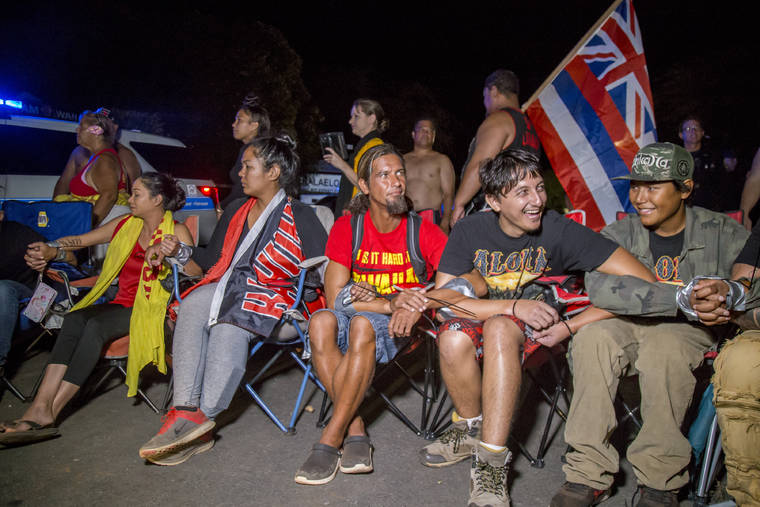Protest is crucial as free expression in any democracy, and it can foster change that serves the community well. It is not an end in itself, however, and the turn of events over the last few months of the Thirty Meter Telescope demonstrations show the ways things have gone awry.
In recent weeks, the barricade-style of protests associated with the TMT setting has spilled out in other areas: the Waimanalo site of a ball park in what’s known as Sherwood Forest, the long-controversial Pohakuloa military training area and, most dramatically, the North Shore obstruction of a convoy to construct the Na Pua Makani windfarm project.
The latter upheaval peaked Friday morning with arrests and what’s described as the intentional downing of a utility pole, the lines crossing Kamehameha Highway and stalling the convoy. This presents the larger community with blackouts, inconvenience, hazards — which is not a good outcome for a movement that sets out to adopt a peaceful tone.
That’s because despite the principles set out by a movement’s leadership, it’s impossible to control how any protest plays out. The resulting chaos this brings has set off alarm bells among business executives. With good reason, they wonder: How can anyone invest time and money in the government’s approval process if obstruction is the ultimate end, regardless?
In the wake of the TMT project receiving its permit for construction atop Mauna Kea, project opponents adopted the mantle of “protectors” (kia‘i). They advocated for an adaptation of nonviolent resistance called “kapu aloha” — meaning restraint, but with compassion.
Gov. David Ige, who first had closed the highway the protesters used to access and block the road to the summit, responded to that approach by reopening the highway, seeking a less confrontational pursuit of a solution.
Calling all sides to the table would have been fine, but not what happened next: simply yielding and allowing the crowds to overwhelm the slopes. That was a failing of leadership, one that amounted to tacit approval.
Hawaii County Mayor Harry Kim was tasked to find a solution. In the interim, though, word spread through social media, the crowds grew and kapu aloha became a full-fledged movement. And, as everyone has witnessed, it has caught on.
A movement can be a positive force, and Native Hawaiians could use that. Most long-time residents of Hawaii will acknowledge the toll that history has taken on its indigenous population, and that efforts to deliver promised rights to Hawaiians have been incomplete at best.
In the case of TMT, the 10-year review process was plainly flawed, a fact that led the state Supreme Court to kick the permit application back to the Board of Land and Natural Resources to start over.
For Hawaii as a whole, community engagement can be lacking, with both sides bearing some of the fault for being late to the conversation. But for Hawaiians in particular, a longstanding sense of grievance has fueled the protests. And the kia‘i have taken this occasion to draw a red line. No TMT deal, no way.
That may feel right, emotionally. But rarely in a democracy can that intransigence be allowed to stand — especially here, where every hurdle has been cleared.
Kim, in response to the governor’s request, did devise a plan for a settlement, one that would include TMT as the last telescope to be developed on the mountain. The plan recaps several steps already taken (pledges for community benefits and decommissioning five older telescopes). And it includes a newer pledge from the University of Hawaii Mauna Kea managers to overhaul the summit governance and include more Hawaiian representation.
More recently, the UH Board of Regents is codifying some ideas in a welcome action plan that features a time frame for the removal of the old telescopes. That’s a promise that needs to be kept.
But both of these blueprints include the TMT, and the kia‘i leaders have said that’s a nonstarter. By inference, that means no compromise at all, insisting that one side gets everything it wants and the other gets nothing.
Moreover, peaceful resistance, also known as civil disobedience, assumes the willingness of the resisters and the disobedient to accept the consequences that their actions bring. There have been very few consequences at the Mauna Kea Access Road, and even the encampment facilities have been allowed to remain and the barriers to harden.
Nevertheless, they must be cleared — a painful step the state must take lest Hawaii lose something with the potential benefit of a world-class telescope. The erosion of public support is evident, but that does not negate the immense promise of this project, its leaders having followed every procedural step the state laid out.
Native Hawaiians can claim some significant wins through kapu aloha, by considering the shared-governance plan the state has offered. Some sincere negotiating is what’s needed now — a little aloha, now that kapu has fulfilled its role.

